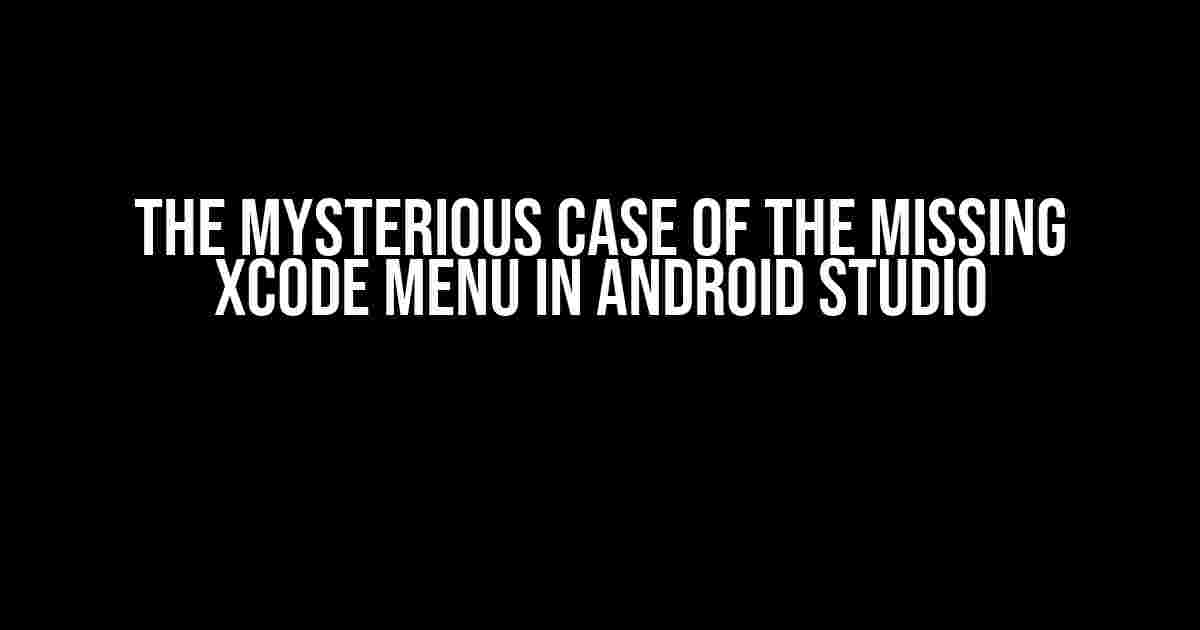If you’re reading this article, chances are you’re stuck in a confusing predicament. You’ve opened Android Studio, eager to start building your next big app, only to realize that there’s no menu for Xcode. You’ve scoured the entire interface, clicked every button, and poked every corner, but that pesky Xcode menu remains elusive. Fear not, dear developer, for we’re about to unravel the mystery behind this disappearing act.
The Xcode Conundrum: What’s Going On?
Xcode, the integrated development environment (IDE) created by Apple, is primarily used for developing software for iOS, macOS, watchOS, and tvOS. Android Studio, on the other hand, is the official IDE for Android app development. It’s like apples and oranges – two distinct ecosystems that don’t mix. So, it’s no wonder that Xcode isn’t a part of the Android Studio menu.
The Android Studio Menu: A Quick Tour
Let’s take a quick look at the Android Studio menu to understand what’s available and what’s not. Here’s a breakdown of the main menus:
- File: Create new projects, open existing ones, and manage your project structure.
- Edit: Modify your code, find and replace text, and refactor your codebase.
- View: Customize your interface, toggle various UI elements, and adjust the layout.
- Navigation: Jump between files, classes, and symbols with ease.
- Build: Compile, run, and debug your project.
- Run: Execute your app on an emulator or physical device.
- Tools: Access various utility tools, such as the Android SDK Manager and the Layout Editor.
- VCS: Manage your version control systems, like Git.
- Help: Get assistance, check for updates, and access the Android Studio documentation.
Notice anything missing? That’s right, there’s no Xcode menu in sight!
But I Need Xcode for My iOS App!
Don’t worry, we’re not leaving you high and dry! If you’re an iOS developer or want to create an iOS app, you’ll need to use Xcode. Here’s what you can do:
- Download and install Xcode from the Mac App Store (if you haven’t already).
- Launch Xcode and create a new project or open an existing one.
- Choose the correct template for your iOS app (e.g., Single View App, Tabbed App, etc.).
- Configure your project settings, such as the target platform, Swift or Objective-C, and more.
// Example Xcode project structure MyApp MyApp Info.plist Main.storyboard AppDelegate.swift SceneDelegate.swift ...
Can I Use Android Studio for iOS App Development?
The short answer is no. Android Studio is specifically designed for Android app development, and it’s not compatible with iOS development. You’ll need to use Xcode for iOS app development and Android Studio for Android app development.
However, there are some alternatives that allow you to develop cross-platform apps using a single IDE. For example:
- Flutter: An open-source mobile app development framework created by Google. You can use Android Studio or Visual Studio Code as your IDE.
- React Native: A framework for building cross-platform apps using React and JavaScript. You can use Android Studio, Visual Studio Code, or a code editor of your choice.
- Xamarin: A framework for building cross-platform apps using C# and .NET. You can use Visual Studio as your IDE.
Keep in mind that each framework has its own set of tools, libraries, and requirements, so be sure to research and choose the one that best fits your needs.
Conclusion: The Xcode Enigma Solved
In conclusion, the absence of an Xcode menu in Android Studio is not a bug or a feature; it’s simply a consequence of their different design goals and target platforms. By understanding the distinct roles of Android Studio and Xcode, you can focus on developing amazing apps for both Android and iOS devices.
Remember, as a developer, you have the power to choose the right tools for your projects. Whether you’re an Android enthusiast or an iOS aficionado, there’s a world of possibilities waiting for you.
| IDE | Platform | Language(s) |
|---|---|---|
| Android Studio | Android | Java, Kotlin, C++ |
| Xcode | iOS, macOS, watchOS, tvOS | Swift, Objective-C |
| Flutter | Cross-platform (Android, iOS) | Dart |
| React Native | Cross-platform (Android, iOS) | JavaScript, JSX |
| Xamarin | Cross-platform (Android, iOS) | C#, F#, Visual Basic .NET |
Now, go forth and create amazing apps that delight users across both Android and iOS platforms!
Happy coding!
Frequently Asked Question
Are you spinning your wheels trying to find Xcode in Android Studio? Relax, we’ve got the answers for you!
Why is Xcode not an option in Android Studio menus?
Xcode is an Integrated Development Environment (IDE) created by Apple, exclusively for developing software for macOS, iOS, iPadOS, watchOS, and tvOS. Android Studio, on the other hand, is a separate IDE developed by Google for building Android apps. Since Xcode is specific to Apple’s ecosystem, it’s not a viable option within Android Studio.
Can I use Xcode for Android app development?
No, Xcode is not designed for Android app development. It’s primarily used for building apps for Apple devices. If you want to develop Android apps, you’ll need to use Android Studio or other compatible IDEs.
Is there an equivalent to Xcode for Android app development?
Android Studio is the official Integrated Development Environment (IDE) for Android app development. It provides a comprehensive set of tools for building, testing, and debugging Android apps.
Can I switch between Xcode and Android Studio for different projects?
Yes, you can use both Xcode and Android Studio depending on your project needs. However, keep in mind that they’re designed for different ecosystems, and you’ll need to familiarize yourself with the specific tools, languages, and frameworks required for each platform.
Are there any alternatives to Xcode and Android Studio?
Yes, there are alternative IDEs for both iOS and Android app development. For example, Visual Studio Code, IntelliJ IDEA, and Unity are popular alternatives to Xcode and Android Studio. Research and explore these options to find the one that best fits your development needs.
